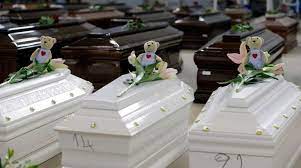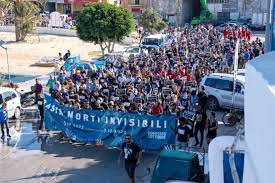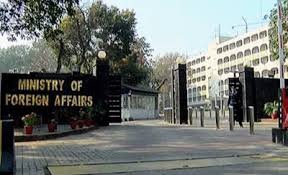Refugees who died off Italy 10 years ago remembered as new crisis flares

Lampedusa: Vito Fiorino woke up in his boat to piercing screams. It was 6am on October 3, 2013, and the Italian fisherman had spent a rare night out at sea with his crew, hoping for a good catch.
They scanned the dimly lit sky expecting to spot a flight of seagulls mewing in the distance. Instead, as the group sailed towards the noise, the scene that awaited them was one they had never seen.
“We woke up to an immeasurable tragedy,” Fiorino said. “There were hundreds of people in the sea, screaming and crying for help.”
A rickety trawler carrying asylum seekers from Eritrea and Somalia had capsized a short distance off Italy’s Lampedusa, a holidaymaker’s dream island known for its azure waters and sandy beach.

Only 155 people survived, while 368 people drowned.
The fishermen pulled 47 people onto their vessel before Italian authorities arrived.
Days later, on October 11, a second vessel loaded with mostly Syrians fleeing the war-ravaged country capsized some 32km (20 miles) off the coast, killing 268 people, including 60 children.
Ten years to the day, Fiorino joined Italy’s annual day of remembrance for the victims of the 2013 shipwrecks and the thousands of refugees who have perished at sea since.
He lit candles on Tuesday around an elliptical monument he designed and installed in Lampedusa’s Piazza Piave. Swirling around the iron skeleton of a boat, the names of those who died in the shipwreck converged on a blue pedestal symbolising the sea.
Beside him, survivors and the fishermen who had saved their lives locked in an embrace, sobbing quietly.
Adhanom Rezene, who was 22 when he fled Eritrea, lost childhood friends in the shipwreck.
“It is important for me to be here to remember them. I don’t want to forget,” he told Al Jazeera. “We are not just numbers, we are human beings and we came in search of freedom, and peace.”
The unprecedented scale of the double tragedy, a stone’s throw from Italy’s southernmost strip of land, shook the conscience of European officials at the time.
Jose Manuel Barroso, then-president of the European Commission, flew to Lampedusa, where teddy bears and flowers adorned hundreds of small white coffins, an image Barroso said would “never get out of my mind”.
“The kind of tragedy we have witnessed here so close to the coast should never happen again,” Barroso said.
Yet, similar tragedies have occurred time and again and the Italian island, with a population of just 6,000, is once again at the centre of a European refugee crisis.
Last month in Lampedusa, as thousands of asylum seekers were crammed in a centre designed to accommodate 400, the Italian Coast Guard found the body of a newborn baby who died on the journey.
Days earlier, a five-month-old boy drowned after a boat capsized a short distance from the coast.
In February, at least 94 people, including 35 children, died after a boat carrying refugees sank off the Italian coastal city of Cutro, in the southern region of Calabria.
Vincenzo Luciano, a fisherman who attempted to save lives during the recent Cutro shipwreck, shared his testimony with a group of students in Lampedusa.
“Unlike Vito, I couldn’t save anyone. I took 13 children out of the water, but they were all dead,” he said. “The youngest one was eight months old. He died in my arms.”
Since 2014, the International Organization for Migration (IOM) says 28,105 people have been recorded as missing, but the real numbers are likely to be significantly higher.
So far this year, at least 2,517 people have died while crossing the Mediterranean, according to the United Nations refugee agency UNHCR – more than last year’s grim toll.
Survivors of the 2013 shipwrecks and relatives of the victims on Tuesday accused Italian and European institutions of prioritising their borders over lives.
Emmanuel Ghebreyusu, 53, said his niece would have been 30 today had she survived.
“It has really been tough over the past 10 years,” said Ghebreyusu, as crowds marched to the 5-metre (16-foot) high Gate of Europe monument, where they tossed flowers in the sea, a poignant symbol of their mourning.
“I wish authorities would do more to save lives. Human lives are more important than anything,” he said.
In the aftermath of the 2013 shipwrecks, Rome launched a state-led operation to patrol the Mediterranean – calling it Mare Nostrum, the Roman name for the Mediterranean Sea – that saved more than 150,000 lives in its year of activity.
However, the naval mission was suspended in 2014 after the EU refused to contribute to its operational costs.
According to humanitarian groups that try and save refugees in peril, since then, the policies governing search and rescue operations have focused on pushbacks, the criminalisation of NGOs, and deliberate delays.
Rossella Miccio, head of the Italian non-governmental medical organisation Emergency, which operates the vessel Life Support, told Al Jazeera that Rome is “clear and explicit” in its desire to hamper the work of NGO ships.
The government of far-right Prime Minister Giorgia Meloni, whose election campaign a year ago called for a naval blockade of North Africa to curb arrivals, has adopted decrees which limit NGO vessels to one rescue at a time, after which they must immediately disembark.
The organisations say the Ministry of the Interior often assigns far-flung ports to disembark, limiting the boat’s availability to carry out search and rescue operations. At times, they have been assigned distant northern Italian ports, far from the stretch of the Mediterranean Sea where they operate.
“These policies curtail search and rescue operations and bring more deaths and pullbacks,” Miccio said.





